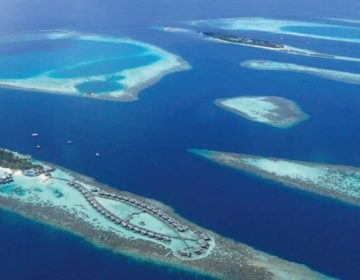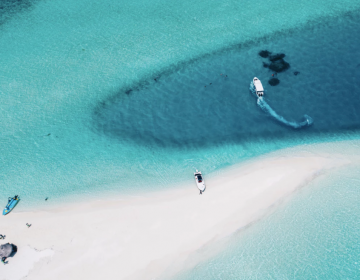Kuda Kandu
On the northwest side of Kassan Faru Kandu is a channel dive with a steep reef between one and 30 meters. The best diving is between 10 and 20 meters near the corner where there is a large rock rising to three meters. The cave on the corner between 10 and 25 meters and the abundance of fish life make this a favorite site with divers.
There are cliffs from five to 25 meters, overhangs and one big cave at 20 meters with a swim-through to 10 meters and many sea fans. Reef fish to be seen include grouper and squirrelfish in the caves, Moorish idol and long-nosed butterfly fish, which are attracted to the many small invertebrates on the steep walls. Schools of black pyramid butterflyfish swim off the reef edge feeding on zooplankton. Large schools of barracuda, some tuna, the occasional grey reef shark, and large Napoleon are all to be seen here.
 Schools of black pyramid butterflyfish swim off the reef edge feeding on zooplankton.
Schools of black pyramid butterflyfish swim off the reef edge feeding on zooplankton.
Far Reef
The best diving is at a large set of coral rocks between 10 and 15 meters where commonly observed reef fish include oriental and harlequin sweetlips, blue-striped snapper, trumpet fish and grouper. At the approach to the rocks on the south side is a sandy gutter that lies between the reef proper and a finger of reef further out. The sandy gutter rises from 30 to 20 meters near the rocks, and on the sand, a few white-tip reef sharks and stingrays can usually be seen.
Miyaru Faru
Miyaru means shark in Dhivehi, and this is a great place to view the grey reef shark. A large overhang at 28 meters on the outside corner of Thulhaagiri Kandu is an ideal place to stop and view sharks. They are mostly seen with an incoming current. Visibility is usually good at these times and when holding on at the overhang great numbers of pelagics, such as barracuda, trevally, and tuna can be seen. Eagle rays are surprise visitors here and often grazing along the reef are powder-blue surgeonfish.
 Powder-blue surgeonfish are often seen grazing along the reef.
Powder-blue surgeonfish are often seen grazing along the reef.
Miyaru Thila
Nearby in the same channel is a long and narrow Thila with many big coral rocks off the northwest side — big schools of fusilier cover this interesting Thila, also Napoleon fish, eagle rays and trevally. Often grazing along the reef are powder-blue surgeonfish. The best diving is with an in-going current.
Prisca Head
This is a classic channel dive, starting on the outside corner where there are many caves to 25 meters. There is one big cave at 20 meters with a swim-through to 10 meters and many sea fans. Colorful reef fish include Moorish idol, bannerfish, and schools of black pyramid butterflyfish. Large schools of barracuda and tuna swim through the channel.
 Colorful reef fish n this dive include bannerfish.
Colorful reef fish n this dive include bannerfish.
Longreef
Inside Dhiffushi Kandu is Longreef. In a strong current, it can be dived with Prisca Head. The total length of this reef is four kilometers, so it is not surprising that this is a popular drift diving location. The reef slope changes from steep with many caves at the eastern end to a vertical wall further inside.
Prisca Corner
The outside reef offers deep, clear water with the chance of seeing sharks and big schools of fish. On the corner are several caves – three huge ones – one of which starts at 28 meters and rises with a swim-through to 15 meters. Tall-fin batfish slice through the currents around the entrance to this cave. A conglomeration of coral rocks lies in shallow water at 10 meters on the outside reef and here mantas visit during the south-west monsoon. A large number of cleaner wrasse living among the rocks await their visit. There are plenty of sponges, sea fans and feather stars deeper on the corner and inside the caves are grouper, squirrelfish, and bigeye. At least two species of anemonefish, Clark’s anemonefish, and the black-footed anemonefish are common on the lower part of the reef at 20 meters just inside the channel.
 Clark’s anemonefish
Clark’s anemonefish
Cave Corner
There are big caves to a maximum depth of 28 meters. Inside there are many sea fans and soft coral, while on the reef are large schools of snapper. Both experienced, and novice divers will find this an exceptional dive. The best diving is on the north side where the reef drops steadily from three to 25 meters to a ridge that pushes northwards for 100 meters. On the ridge are isolated coral patches surrounded by large schools of humpback and blue-striped snapper. A pair of coral pinnacles on the ridge, five meters high, is one of the most unusual coral formations to be found in the area. Around the reef, turtles and remoras can be seen, while on the reef top are healthy stands of hard coral.
 On the ridge are isolated coral patches surrounded by large schools blue-striped snapper.
On the ridge are isolated coral patches surrounded by large schools blue-striped snapper.
Westrock
This is a small reef inside the atoll. It is a good beginner dive with the best diving on the southeast side between five and 15 meters. The reef slopes to a sandy base at 15 meters where garden eels and stingrays are common. The reef top has good coral.
 Garden eels
Garden eels
Bodu Giri
A larger reef ideal for beginners with a maximum depth of 20 meters. The best diving is on the northwest side where there is a steep wall with many blue triggerfish and masked bannerfish. High on the wall are lobsters, sea anemones and occasionally turtles.
 Blue triggerfish
Blue triggerfish
Meeru Corner
One of the most popular dives in the area is Meeru Corner. It is located on the outside corner at the north end of Dhiffushi Falhu. The reef drops vertically from five to 30 meters to a section called the ‘wall. This part of the reef offers a unique experience to divers found in a few other locations. This unusual coral formation is like an apartment building with levels rising from 30 to 10 meters on the outside of the reef. It has many reef dwelling occupants, and its nooks and crannies appear overcrowded with reef fish. On the reef at the base of the stairs are white-tip reef sharks and turtles while stingrays are regularly seen on the outlying sandy patches. Several species of grouper and giant morays prefer the ground floor apartments, while oriental sweetlips, surgeonfish, and pufferfish have staked a claim upstairs. Large schools of yellow sweeper seem to have no preference and occupy all levels.
 On the reef at the base of the stairs are white-tip reef sharks.
On the reef at the base of the stairs are white-tip reef sharks.
Diving Hints
Currents are not usually strong here, and this dive is suitable for all experience levels. Having dived the deeper depths, divers can make their way back up the reef to spend the remainder of the dive on the reef top. If the surf is crashing on the reef, divers should swim away from the reef at the end of the dive and make an open water safety stop.
Colosseum
On the outside corner in the ‘Colosseum,’ a semi-circular cliff 40 meters long and two meters high at a depth of 24 meters. With an incoming current, this is a good place for divers to anchor themselves and watch pelagic fish in action. Barracuda, big-eye trevally, blue-fin jack, rainbow runner, and dog-toothed tuna are persistent performers here, while grey reef shark, Napoleon, and eagle rays frequently drop by. Soft corals flourish on the reef slope leading into the channel and turtles graze here. Once inside the channel, the wall banks up to steeply into layers of ledges with caves in the shallower depths at 15 meters. The long reef gives divers the opportunity to drift dive well inside the atoll.
 Dog-toothed tuna
Dog-toothed tuna
Chicken Island (Kukulhu)
On the outside of the reef are coral rocks around 10 meters where many reef fish are to be found, including black-spotted and scribbled puffers. A couple of caves at 20 meters are worth a look, then a long drift into the channel follows, until reaching a great overhang spiraling down from three to 25 meters. This is the start of a 100-meter section of cliffs, caves, coral rocks and swim-throughs – well worth exploring. Soft coral is a feature in a cave at 15 meters, and morays are common among the overhangs.
 Scribbled puffers can be found on the coral rocks on the outside of the reef.
Scribbled puffers can be found on the coral rocks on the outside of the reef.
Diving Hints
The north side of Thulusdhoo Kandu extends into the atoll for almost two kilometers, so if the current is too strong on the corner, a less stressful and safer dive can be made anywhere along this channel wall.
Experience these once-in-a-lifetime dives and book your hotel here.
(Source: Dive Maldives: A Guide to the Maldives Archipelago. Tim Godfrey. Atoll Editions, 2015)



